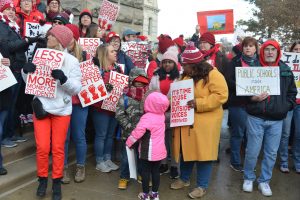Indiana schools already preparing for possible second wave of virus
A growing number of Indiana educators are beginning to prepare for remote instruction to go into the next academic year.
A growing number of Indiana educators are beginning to prepare for remote instruction to go into the next academic year.

The most pressing education issue in Indiana has quickly shifted from increasing teacher salaries to mitigating how much progress students will lose with school buildings shut down through the end of the academic year.
Indiana will receive $215 million of the $13.5 billion that the federal government is handing out to states for schools as part of the COVID-19 rescue package.
All Indiana schools will close through May 1, and all state standardized tests are canceled in response to the quickly spreading coronavirus, Gov. Eric Holcomb announced on Thursday. He also said it’s possible that the closures could be extended through the end of the school year. “As we get near to May 1, we may […]
It’s up to each district to decide whether to pay hourly workers—including bus drivers, custodians, food service employees and paraprofessionals—who are typically paid only for days when students are present.
Without an exemption approved last month, most schools would have received a D or an F. That would have affected teacher’s evaluations, and therefore pay, and put many schools on the path to state intervention.
The pilot would have allowed seniors behind on credits to be counted as graduates in Indiana if they pass a high school equivalency exam and take steps toward career training.
Schools won’t be punished for low test scores earned during the first two years of the state’s new ILEARN test—a move by state lawmakers Monday that will render schools’ 2019 and 2020 state grades essentially meaningless.
Users of the newly launched INview will have more immediate access to how much schools and districts are spending per student, as well as how that figure compares to the state average and other schools with similar demographics.
The State Board of Education’s decision to end the takeover confirmed the waning enthusiasm in Indiana for state oversight of failing schools. But it also revealed how much Indianapolis Public Schools has transformed in recent years.
It remains to be seen whether this week’s Red for Ed rally at the Indiana Statehouse will lead to policy changes sought by teachers, but here are five things that could result in the near future.
The thousands of teachers descending on the state capitol Tuesday face an uphill battle when it comes to getting elected officials to raise their salaries. But top lawmakers appear open to changes on other issues.
Tuesday’s fast-growing rally is expected to cancel school for half of the state’s students while as many as 12,000 teachers descend on the Indiana Statehouse to make a list of demands.
So many teachers asked to take Nov. 19 off to rally at the Indiana Statehouse for higher pay that nearly 30 districts across the state have canceled school or scheduled e-learning days.
Amid concerns over low scores on Indiana’s new standardized test, ILEARN, new results from a national exam tell a similar story about student performance.
The Indiana General Assembly’s interim study committee on tax and fiscal policy asked for ideas from the public and heard over two hours of testimony on Tuesday.
Here’s a roundup of all of the state school districts that will put a tax increase on the ballot in November, including a couple of school districts with both construction and operational referendums.
Rep. Ed DeLaney, D-Indianapolis, put forward a plan this week to raise teachers’ salaries. Among his proposals: give school districts incentives to set minimum pay at $40,000, and freeze corporate tax rates to pay for it.
Indiana’s State Board of Education on Wednesday passed a major change to how it grades schools—and then, at the very same meeting, voted to reverse its own decision.
On Tuesday, an interim committee of lawmakers discussed potentially consolidating the state board of education, governor’s workforce cabinet, and Commission for Higher Education.